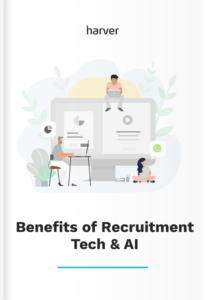Companies who do high-volume recruitment often say that their biggest problem is not being able to find good candidates. Yet, even in a tight labor market, there are plenty of people looking for jobs.
So what’s actually happening? What are employers doing wrong?
It’s usually one of the two: they either rely on linear and outdated hiring processes that are designed to work as filters instead of conversion drivers, or they fail in creating a strong employer brand and marketing their vacancies.
We’ve covered the process problem in a previous article, so in this article we’ll focus on recruitment marketing – we’ll outline the current state of affairs, as well as the best practices you might consider implementing for your recruitment marketing strategy 2022.
What’s in?
Like what you see?
Don’t miss out. Subscribe to our quarterly digest to get the latest TA and TM resources delivered right to your inbox.
Brief overview of recruitment marketing: What does it mean
In practice, recruitment marketing is the combination of tactics and methods used to market an employer’s brand to candidates, with the purpose of attracting talented candidates to an organization.
It’s one of the first steps in the hiring process, the main goal of recruitment marketing being to convince job seekers to apply to the vacancies a company has available.
Recruitment marketing helps employers build awareness and visibility around their values and company culture, and is a key element in engaging and nurturing potential talent.
It improves candidate experience (CX) by delivering pertinent information to all candidates in a timely manner through targeted, personalized messaging and communication, resulting in more meaningful engagement.
Recruitment marketing is how high performing companies attract candidates; it’s what gives leading employers their competitive advantage.
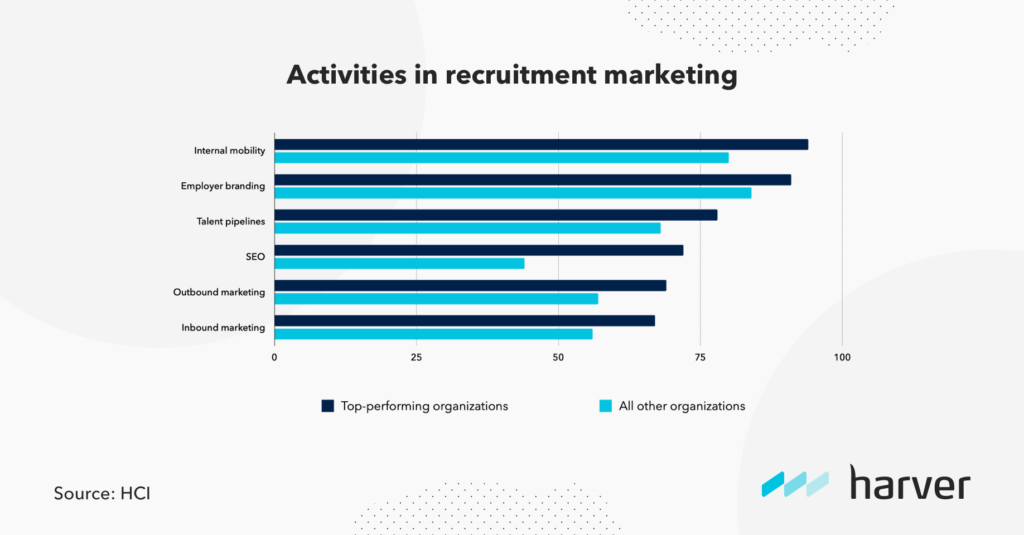
Recruitment marketing in 2022: Main findings
Now let’s dive right into the topic and see what the latest research on the state of recruitment marketing says about the main challenges, ways of working, and goals of employers in 2022.
1. Top recruitment marketing challenges
Labor shortage and lack of talent pipeline
78% of companies report being unable to find enough candidates in the market to fill their open roles. Without people to keep the business operations successful, many retailers and restaurants have had to close premises or reduce operating hours.
Passive recruitment marketing simply isn’t attracting, engaging and nurturing enough talent to meet current needs, let alone future needs. As a result, 19% of companies say they don’t have a talent pipeline or talent network filled with potential candidates in place to tap into.
But to be successful long term and attract the best talent, requires a proactive approach. And that starts with recruitment marketing. It means filling your talent pool with passive candidates who are a good fit for your organization and building a relationship with them even before relevant roles become available.
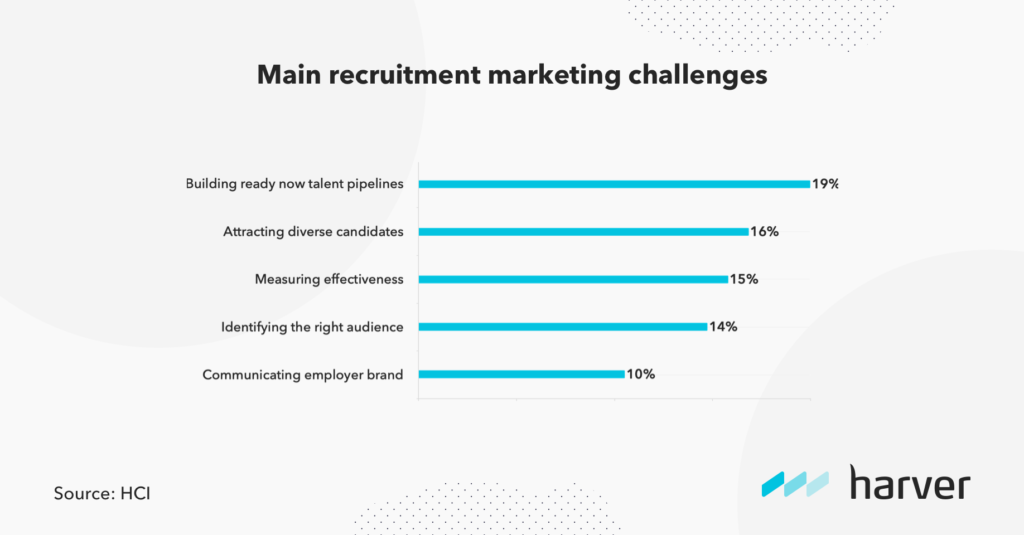
Lack of resources and skills
While companies are aware they need to invest in recruitment marketing to meet staffing demand, most still lack the resources, the staff and the strategy to implement an appropriate, active recruitment marketing strategy:
- 60% of companies don’t have access to the right resources on their talent acquisition team to support their marketing strategy and develop brand awareness.
- 67% don’t have a dedicated role in their talent acquisition team to focus on recruitment marketing.
- Only 57% rely on data to make recruitment marketing decisions.
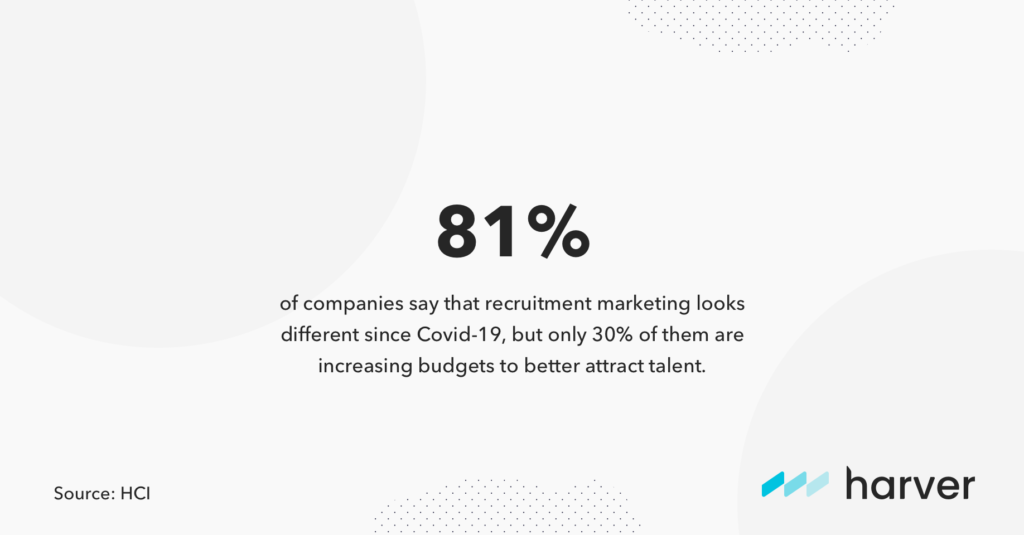
Unable to attract diverse candidates
16% of companies say they’re unable to find diverse talent. But, it’s unlikely to be the pipeline that’s at fault here. It’s more likely that recruitment processes and perceptions, or lack thereof, is resulting in a lack of diversity.
If we look at the latest reports from the Bureau of Labor Statistics, we see that the number of unemployed people searching for a job is extremely high – 5.4 million in February 2022.
There is definitely a wealth of diverse talent in the job market. If it’s equity and inclusion that an organization is lacking, the key is to look at the starting point of the hiring pipeline and consider improving recruitment marketing efforts.
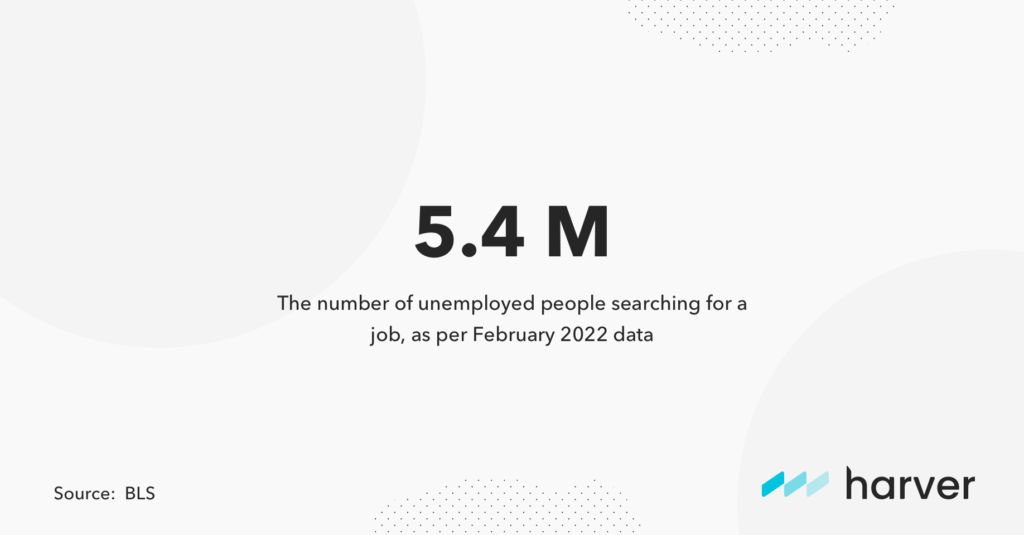
Inability to measure effectiveness of efforts
How do you know if your recruitment marketing efforts are working if you’re not measuring them?
Yet, 15% of companies aren’t set up to measure the effectiveness of their marketing efforts. And if you don’t know what is or isn’t working, how can you tweak and adjust to ensure maximum efficiency?
Unable to identify target audience
14% of businesses aren’t able to identify their target audience. Yet, recruitment marketing is the most effective when it targets a specific audience or persona.
A one size approach does not work here. Different audiences require different approaches – different communication strategies, different engagement plans – for example, a recent graduate strategy is unlikely to be effective for internal hires, or attracting military veterans.
2. Main goals of recruitment marketing
On a strategic level, there are multiple goals of recruitment marketing, including:
- Building a strong talent pipeline and keeping it flowing with a steady stream of top talent
- Getting candidates interested in your organization enough to apply for open positions
- Building awareness of your company and employer brand
- Allowing you to stand out and differentiate your company for the right talent
On a tactical level, goals of recruitment marketing include:
- Attracting more job applicants
- Attracting more high quality candidates
- Increasing candidate engagement
- Increasing employer branding awareness
- Increase traffic to their careers page or career website
- Build social media profile
- Increase employee referrals
- Increase job offer acceptance rate
- Increase diversity among applicants
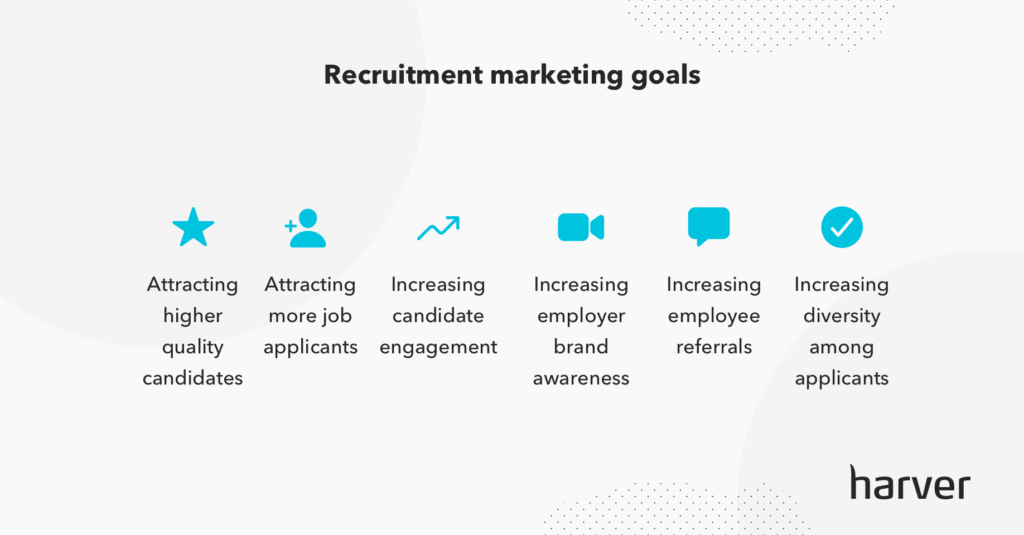
3. Stakeholders typically involved in recruitment marketing
Recruitment marketing isn’t an activity that happens in a silo – it isn’t an isolated process. It usually happens in congruence with wider organizational efforts, meaning there are typically multiple stakeholders involved. These can include:
- Talent acquisition team
- Head of talent acquisition / CHRO
- HR
- Corporate marketing team
- Chief diversity officer
- Employee resource groups (ERG)
- CX managers
4. Candidate volume is relatively stable across industries
Despite the unemployment rate fluctuating wildly over the last few years, recruitment metrics revealed that candidate volume rate has remained relatively stable across all industries.
Where layoffs and furloughs were expected to increase candidate volumes across the board, the anticipated tsunami of applications failed to materialize. Personal health concerns, government financial incentives and lack of childcare all contributed to would be job seekers refraining from job hunting.
5. Unemployment and apply rates
For years, research has shown a direct correlation between unemployment rate and apply rate. However, while December 2020 saw an unemployment rate of 2X December 2019 rate – 6.7% in 2020 vs 3.5% in 2019, the apply rates did not increase in parallel.
In fact, in April 2020 when unemployment was at its highest, apply rates dropped to their lowest that year, before tracking at a similar steady, low rate.
Even when faced with a global pandemic and a high unemployment rate, an increase in applicants is not guaranteed – industries need to take steps to increase their application rates.
6. Mobile vs desktop applications
Appcast’s 2021 Recruitment Marketing Benchmark report analyzed job advert data from just under 1300 employers in the US. It looked at 125 million clicks and 7 million applications.
What did the data reveal?
Out of those 125 million clicks, 64.4.% came through mobile, and only 35.6% came via desktop. And of the 7 million applications, 60.7% were from mobile and only 39.9% were from desktop.
In fact, over the last three years, applications from desktops have continued to fall. 2020 saw a 6.7% decrease in desktop applications in comparison to the year previously. And mobile applications were up 21.2% over the same period.
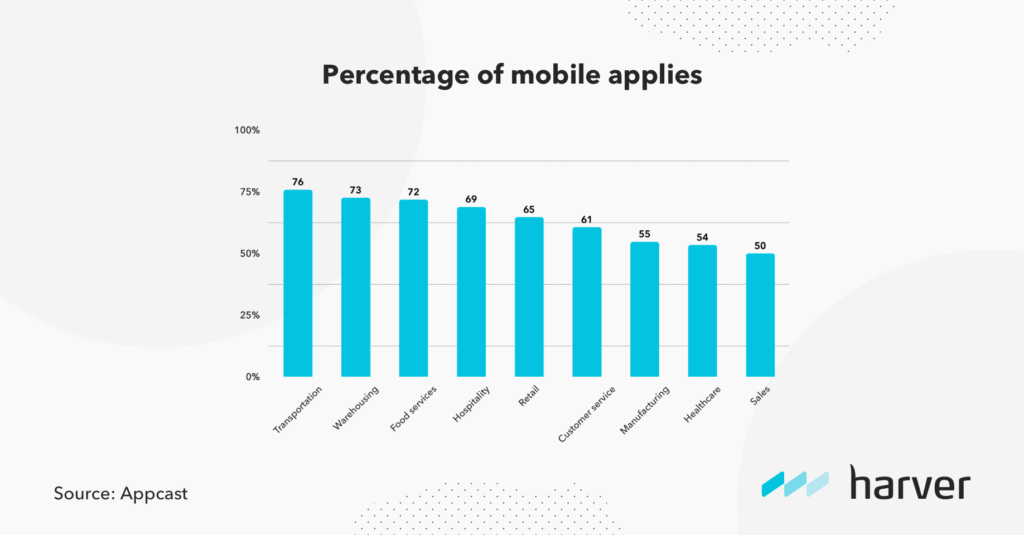
This increase in mobile applications year on year isn’t a new trend, it’s a continuation of an existing move toward mobile. Saying that, desktop still remains the primary source of applications in industries such as administration, HR & staffing, manufacturing, warehousing and logistics, and sales.
7. Applications by day of the week
According to the Appcast data, Tuesday typically has the highest percentage of applies (although there is still a lot of activity on Monday – Thursday still).
Interestingly, mobile applications are the highest at the weekend – 61.4% on Saturday and 61.99% on Sunday. Saying that, the data still suggests that more people apply for jobs during the traditional working week than at the weekend.
8. Communication with candidates
Companies need to be authentic and genuine in their communications with candidates. Communication via social media must be transparent, not proportional. If messages are personalized, companies can build stronger relationships with candidates, increasing CX throughout the application process.
But in order to understand what personalization is required, organizations have to understand their target audiences and segment communications to different cohorts. This is why consistency with communications is key. High performing companies are 2X more likely to communicate more frequently with candidates than other companies.
9. Recruitment marketing tech investments
Technology will streamline recruitment marketing, but only if companies know precisely what processes they’re automating and who their target audience is. Implementing technology for the sake of it will not benefit anyone.
Recruitment marketing technology is designed to improve the top end of the recruitment funnel, automating where even the most advanced ATS can’t. Recruitment marketing technology will give organizations greater insights, help them deliver better CX, track conversion rates, and improve overall efficiency.
Organizations invest in recruitment marketing technology to aid with:
- Career sites
- Candidate sourcing
- Nurturing talent pipeline
- Programmatic advertising
- Data analytics
- CRM
How AI & recruitment technology is changing recruiting experience
Find out how tech has helped other companies grow by enhancing both the recruiters’ and candidates’ experience!
Recommendations for organizations involved in volume hiring
1. Volume hiring companies considering recruitment marketing need to take a holistic approach because recruitment marketing is not an isolated activity.
How you position your employer brand impacts the type of candidates you attract, and has long-term business effects. For this reason, recruitment marketing requires a solid understanding of business objectives, as well as a clear strategy and action plan that connects marketing activities to tangible results.
For example, if your goal is to decrease attrition and increase quality of hire, you need to make sure that your recruitment marketing efforts help you attract higher quality candidates who will stay in the job for longer.
2. Your recruitment marketing strategy can’t be to rely solely on technology, as tools alone can’t solve the problem of not being able to find the right candidates or of convincing them to apply to your vacancies.
Thus, instead of relying on isolated tools and fragmented plans, you need to start with a strategy that takes the full picture into account and helps you translate business and recruitment goals into specific marketing actions.
Then, you need a tech solution that brings all the moving parts together into one coherent picture – from employer branding materials, sourcing channels, and application process steps, to candidate assessments, feedback loops, and data insights.
Technology that accelerates your recruitment process, facilitates mobile applies, and helps you showcase your employer brand and company culture throughout the entire application process; a solution that collects data, centralizes it and makes it readily accessible, so you can make smart decisions when adjusting your recruitment marketing strategy.
Also, you need a solution that enables you to inform candidates about the open roles and shows them the day-to-day reality of working for your organization, while helping you assess if they’re a good fit for your jobs and company culture.
3. Although your recruitment marketing activities will target candidates, the solution you implement for streamlining your recruitment marketing processes and promoting your employer brand should make the hiring experience more enjoyable for both candidates and recruiters.
Your talent team’s time is just as important as your candidates’ time, so make sure you look at the hiring journey from both perspectives and understand all the touchpoints, people, and resources involved in marketing your vacancies and moving talent through the recruitment funnel.
Conclusion
Recruitment marketing provides the competitive advantage that many organizations lack. For talent acquisition to be effective, recruitment has to take place long before a role needs filling. It needs to happen before a candidate even knows they want to apply for a new job within your organization.
To see how Harver can help your volume hiring organization reimagine and redesign your CX, turning it into an application experience that helps you stand out whatever the labor market looks like, book a demo below and make 2022 the year your recruitment marketing gives you the competitive edge.
Ready to transform your hiring process?

